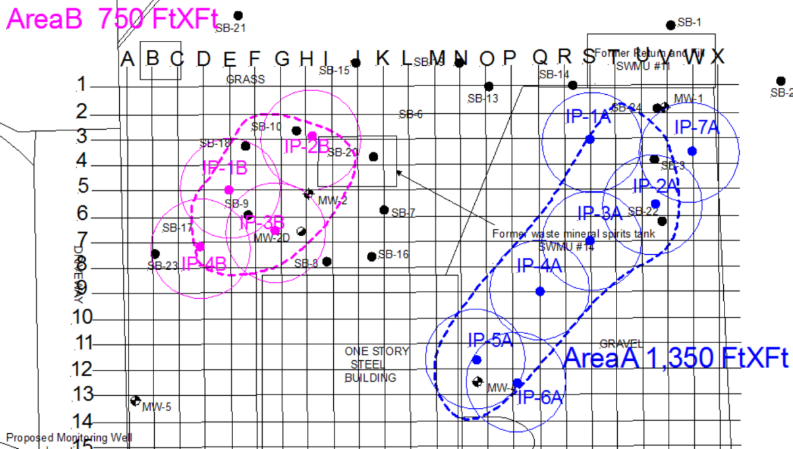Former Gasoline Station – Raleigh, North Carolina
Site: Former Gasoline Station – Raleigh, North Carolina
Constituents of Interest: BTEX, Chlorobenzene, and Naphthalene
Remedial Design and Implementation Contractor: Innovative Environmental Technologies, Inc. (IET)
Project Summary
The site is a former gas station located in Raleigh, North Carolina. The site was contaminated with benzene, toluene, ethylbenzene, xylene (BTEX), chlorobenzene, naphthalene, dichlorobenzenes, and isopropylbenzene. The area of concern was approximately 2,100 sq ft with a target vertical interval from 12 to 30 feet below ground surface (ft bgs). The geology at the site is primarily sandy silt with depth to groundwater at approximately 16 ft bgs. Two areas of concern were targeted utilizing Provect-OX (US Patent 9,126,245), which is an advanced chemical oxidation and accelerated bioremediation technology.
Innovative Environmental Technologies, Inc. (IET) developed the remedial design and applied the Provect-OX to the subsurface via a patented injection process and apparatus (US Patent 7,044,152) such that the activation processes occur in a controlled manner. A total of 11 injection points and 3,600 lbs of Provect-OX were utilized to treat the two areas of concerns (Figure 1).
The Provect-OX rapidly oxidizes the organic contaminants present in soil and groundwater and provides long-term, sustained secondary bioremediation to manage residuals and prevent contaminant rebound. This is accomplished by using ferric iron (Fe III) as a safe and effective means of activating persulfate, which rapidly yields sulfate and ferrate radicals for chemical oxidation treatment. The process also enhances subsequent utilization of sulfate and iron as terminal electron acceptors for facultative redox reactions to support secondary biodegradation of any residual contaminant mass. These sustained biological processes help to minimize or eliminate contaminant rebound that is typically associated with traditional ISCO applications.
Following the Provect-OX application, petroleum hydrocarbon groundwater concentrations in both target monitoring wells have significantly decreased (Table 1). MW-1 exhibits non-detect concentrations for all contaminants of interest (COI) other than xylenes (99% decrease) and 1,4-dichlorobenzne (68% decrease). All COIs in MW-4 were non-detect following the Provect-OX injection program. Additional contaminant concentration decreases in MW-1 are expected due to the iron and sulfate enhanced bioremediation processes.
Table 1. VOC Data for MW-1 and MW-4 (µg/L)
|
|
MW-1 |
MW-4 |
||
|
Sampling Date |
09/12/2012 |
10/02/2013 |
09/12/2012 |
10/02/2013 |
|
Benzene |
0.3J |
ND |
13 |
ND |
|
Toluene |
0.8J |
ND |
2.89 |
ND |
|
Ethylbenzene |
2.5 |
ND |
ND |
ND |
|
Total Xylenes |
82 |
0.9 |
16 |
ND |
|
Naphthalene |
6.6 |
ND |
8.4 |
ND |
|
Chlorobenzene |
1.0 |
ND |
13 |
ND |
|
1,2 – Dichlorobenzene |
18 |
ND |
18 |
ND |
|
1,3 – Dichlorobenzene |
2.7 |
ND |
0.8J |
ND |
|
1,4 – Dichlorobenzene |
9.9 |
3.2 |
3.6 |
ND |
|
Isopropylbenzene |
12 |
ND |
4.2J |
ND |

